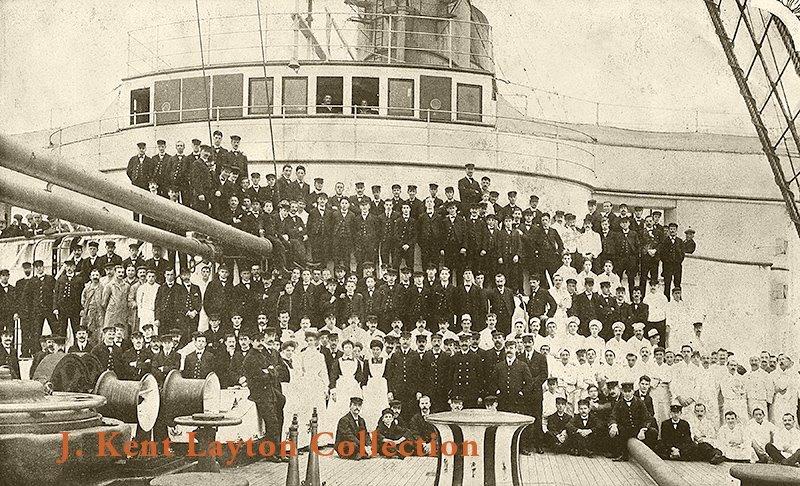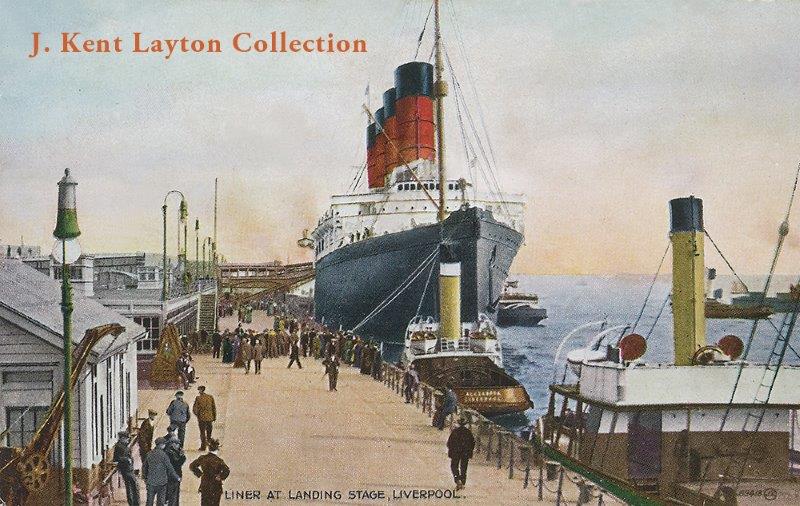Lusitania: a fantastic success
This is the fifth blog post in a series by J Kent Layton, maritime historian and author of ‘Lusitania: an illustrated biography’, to accompany the exhibition Lusitania: life, loss, legacy at the Maritime Museum.

The crew of the Lusitania was like a big family. Here members pose in front of her Bridge on the Forecastle,
apparently after she had just suffered damage in a storm - note the covered windows of her Bridge. © J Kent Layton Collection
Between late 1907 and the late spring of 1914, the Lusitania and her sister, Mauretania, proved to be nothing short of a fantastic success. They were the fastest ships in the world—the Mauretania had a slight advantage, although the Lusitania was hard on her heels the whole way. They were also enormously popular with paying passengers, with bookings frequently running to capacity or over capacity, particularly during the peak season of travel. In fact, throughout her career, extra First Class staterooms had to be installed aboard the Lusitania, at the expense of some former Third Class cabins. Again I have to take a moment to bust another popular myth of maritime lore: frequently it is said that the Lusitania was more popular than the Mauretania between 1907 and 1914; however, the numbers clearly show that the Mauretania was the more heavily booked liner during the years of concurrent service between the ships. Yet as with the speed records, the Lusitania was always a very close second.
During the Lusitania's career, she proved remarkably strong as she fought vicious storms. She even took punishment from enormous 'rogue waves' which flooded her Bridge, waves like something from the films The Poseidon Adventure or the more recent Poseidon. Yet, despite being bruised and battered by the elements, she always emerged like a champion. People gave her more and more trust as she built a record of reliability. Her crew was a largely happy family, and indeed, many who worked aboard her stayed on for months or years at a stretch. Many passengers booked on the Lusitania repeatedly, enjoying her comforts and viewing her as a sort of 'home away from home'. She became like an old friend: strong, reliable, reassuring.
A colour portrait of the Lusitania at the Landing Stage in Liverpool. © J Kent Layton Collection
After the Titanic disaster, extra lifeboats were added to the Lusitania to make sure that enough were provided for all of her passengers and crew. Although this cluttered up the Boat Deck, it was an obvious reassurance that should the unthinkable happen, everyone's safety would be provided for. The success of the Lusitania and Mauretania literally saved the Cunard Company. When they entered service in 1907, the line was literally teetering on the brink of collapse. But by the time construction began on a third liner to pair up with them, eventually named the Aquitania, the company was able to pay for her construction costs completely out of their own coffers, rather than having to rely on a Government loan.
The company continues on today, having survived the turbulent century separating us from the Lusitania, in part built upon the success of she and her sister. As the summer of 1914 began, the two liners were coming up on seven years of age. The Lusitania had experienced her fair share of teething troubles, and of victories. And the future looked bright once they were paired up with the larger, even more luxurious Aquitania that June. But all too soon, that bright looking future turned to one of uncertainty.

